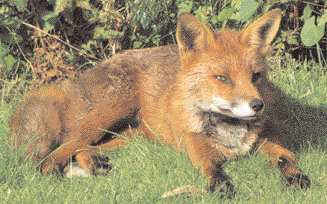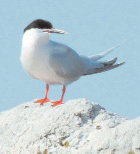|
Wildlife
Newsletter for the Township of Dalkey April 2014 - Michael Ryan |
| We
are all aware how our climate and seasons have changed over the last
three or four decades with various effects on the environment. Drastic
reductions in butterfly and insect numbers occurred during cold wet
summers and though there was a slight reprieve with last year’s
record hot summer, butterfly species that were once our most common,
like Small Tortoiseshell, continue to drop in number. But alongside
the changes caused by climate, a lot of bird species have themselves
created the changes which affected their own circumstances. In the last
40 years there has been a heartening increase in numbers of one of our
most melodious singing summer warblers, the Blackcap. Once only considered
a summer migrant they are now a frequent visitor to garden feeders in
winter and a common summer breeding bird. The wintering blackcaps are
birds that will return to breed in central Europe and have increased
their survival rate by not migrating as far in the winter, instead coming
to western |
|
 Dalkey Fox now seen frequently |
Europe where the milder winters and abundance of garden food can help
them survive and get back to their breeding territory a lot easier and
faster then if they’d migrated to Africa.While the blackcaps that
will be singing all around Dalkey and Killiney hills in summer are birds
that will have wintered in Spain or North Africa before coming here.
It’s thought that these birds aren’t migrating as far south
either, the shorter return distance reducing the risk of loss on their
return journey. Whatever the reason for their success, former Dalkey
resident Dick Coombes, co-ordinator of Birdwatch Ireland’s Countryside
Breeding Bird survey told me that blackcaps have increased by a whopping
15.5% average annually (nationally) over a 13 year span. Whitethroats,
another summer migrant member of the warbler family suffered a catastrophic
90% decline in numbers in the late sixties blamed on a drought in the
western Sahel in Africa but have managed a substantial recovery since.
One pair regularly nested below the Vico Road and a few years ago there
were at least four male Whitethroats singing around the two hills. Sadly,
in decline is the most evocative sounding bird of summer, the Cuckoo.
We’ve had male cuckoos calling on Dalkey and Killiney hills in
recent years but they never seem to connect with a female and although
some can be heard around Wicklow, they have declined nationwide leaving
the west of the Shannon as their stronghold. Another summer visitor,
the Swallow, has declined by 2.6% annually in the east of the country
while Swifts have displayed a even more drastic national decline of
5.6% annually according to the Birdwatch CBS survey. It is a fair assumption
that 40 years ago nobody would have predicted that a number of previously
very uncommon bird species would arrive and spread across the country.
Two species of eagle, the Golden and White Tailed, as well as Red Kites
have been reintroduced by human intervention but Buzzards have made
their own way down from a tiny population in northern Ireland to spread
all over the country. They are now seen in every county and driving
north along the M1 they’re a common sight perched on lamp posts
or quartering fields beside the motorway. They are often seen locally
over Loughlinstown, Cabinteely and Kilbogget parks. What was once our
most commonly seen raptor, the Kestrel, which used to nest in Dalkey
Quarry and above White Rock beach, is sadly in continuous decline while
Peregrine falcons, after years of persecution, are now doing reasonably
well and can often be seen around the coastline. |
||
 Mediterranean Gulls |
I still remember the first time I saw a Mediterranean Gull at Sandycove,
another species, once rare, that now breeds in good numbers in Ireland
and dozens can regularly be seen from the coastal footpath near the
Forty Foot, roosting on the rocks. Another bird that would have been
a newsworthy rarity forty years ago, the unmistakable snowy white Little
Egret, is now a common sight and can be seen in Booterstown Marsh and
virtually any local park that has ponds or streams and they are now
a regular breeding bird in Ireland with nesting colonies in the south
east. And of course |
| one
of the most spectacular birds to arrive in Ireland and successfully
breed in counties Wicklow and Dublin is the Great Spotted W oodpecker.
Once only ever seen as a very rare winter migrant their own arrival
and natural spread across the country as a breeding resident in recent
years was totally unexpected but very welcome. We’ve had an individual
wintering on Killiney Hill and, who knows, they may nest there in the
future. Not so long ago Roseate Terns were one of the most endangered
seabirds breeding in Europe but in the last couple of decades have managed
to grow to a very healthy population in Ireland mainly due to wardening
of the colony on Rockabill Island off the coast of north county Dublin,
where over 2,000 pairs now breed every year. Our own project on Maiden’s
Rock off Dalkey Island succeeded after a number of years in getting
Roseates to breed but subsequently a succession of north easterly storms
washed over the rock in the middle of the breeding season and no Roseates
have nested there since 2012. garden feeders. |
|
  |
Although it’s sad not to have any Roseates there anymore if they have moved to a safer location to breed that’s not too bad. Many animals and birds have modified their behavior within the last forty years ago. Bird species such as Siskins, Linnets, Goldfinches and Bullfinches have become common visitors to |
| Forty
years ago seeing a suburban fox was rare enough, to see one in daylight
was almost unheard of. Now they trot around fearlessly at any time of
the day displaying very little fear of humans. Sadly hedgehog numbers
seem to be in continuous decline possibly due in part to milder winters
waking them from hibernation as well as the huge losses they sustain
on busier roads. I’ve written many times about the red squirrels
on Killiney and the way they are tenuously hanging on despite the influx
of grey squirrels which first appeared in the Killiney parklands in
2005. The boom years caused many wild areas to be removed and developed
but at the same time with greater awareness and appreciation of nature
many suburban gardens have become havens for wildlife and almost a separate
habitat themselves. Twenty years ago Booterstown Marsh was coated in
oil and only supported a handful of roosting birds while now the water
is clean, supporting fish and invertebrates and providing feeding and
roosting areas for geese and hundreds of other birds including Snipe,
Kingfisher and Black tailed Godwits. If anything can be learned about
predicting nature, if you use the last forty years as a example, it
could be that you probably can’t predict anything about nature!
|